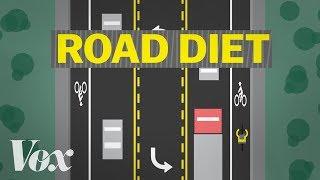Road diets: designing a safer street

Reconfigure the lanes and the traffic will calm.
Subscribe to our channel! http://goo.gl/0bsAjO
Vox.com is a news website that helps you cut through the noise and understand what's really driving the events in the headlines. Check out http://www.vox.com.
Watch our full video catalog: http://goo.gl/IZONyE Follow Vox on Facebook: http://goo.gl/U2g06o Or Twitter: http://goo.gl/XFrZ5H
Over the course of the 20th century, the car became America’s dominant mode of transportation. As vehicle miles travelled soared well past the rate of population growth, demands on the roadway surged. Congestion became a major issue. So transportation planners made the roads wider and added traffic lanes.
Today, we now know that bigger roads and extra traffic lanes do nothing to solve congestion. In fact, it tends to induce even more traffic. So we didn’t fix the congestion issues, and on top of that, we built wide roads that are relatively unsafe.
Transportation planners in the 21st century recognized that many of the roads that were overbuilt could be redesigned to calm speeding and add space for newer multimodal transportation options. And thus, the road diet was born.
The video above explains why road diets are implemented, and how planners survey the feasibility of a lane reconfiguration. You can learn more about road diets with the following resources:
https://www.fhwa.dot.gov/publications/research/safety/10053/10053.pdf
https://safety.fhwa.dot.gov/road_diets/guidance/info_guide/rdig.pdf
https://nacto.org/docs/usdg/conversion_of_four_lane_undivided_urban_roadways.pdf